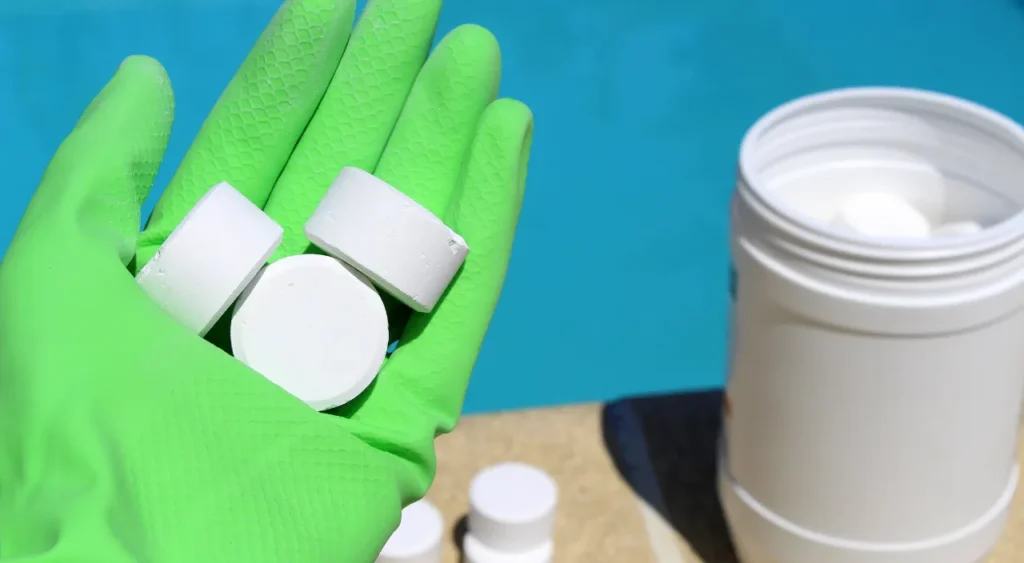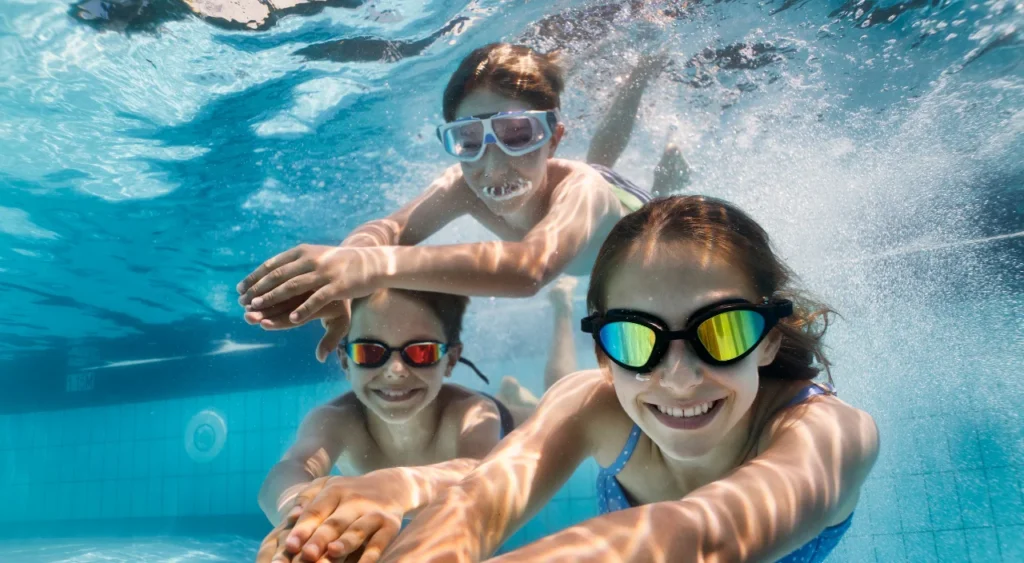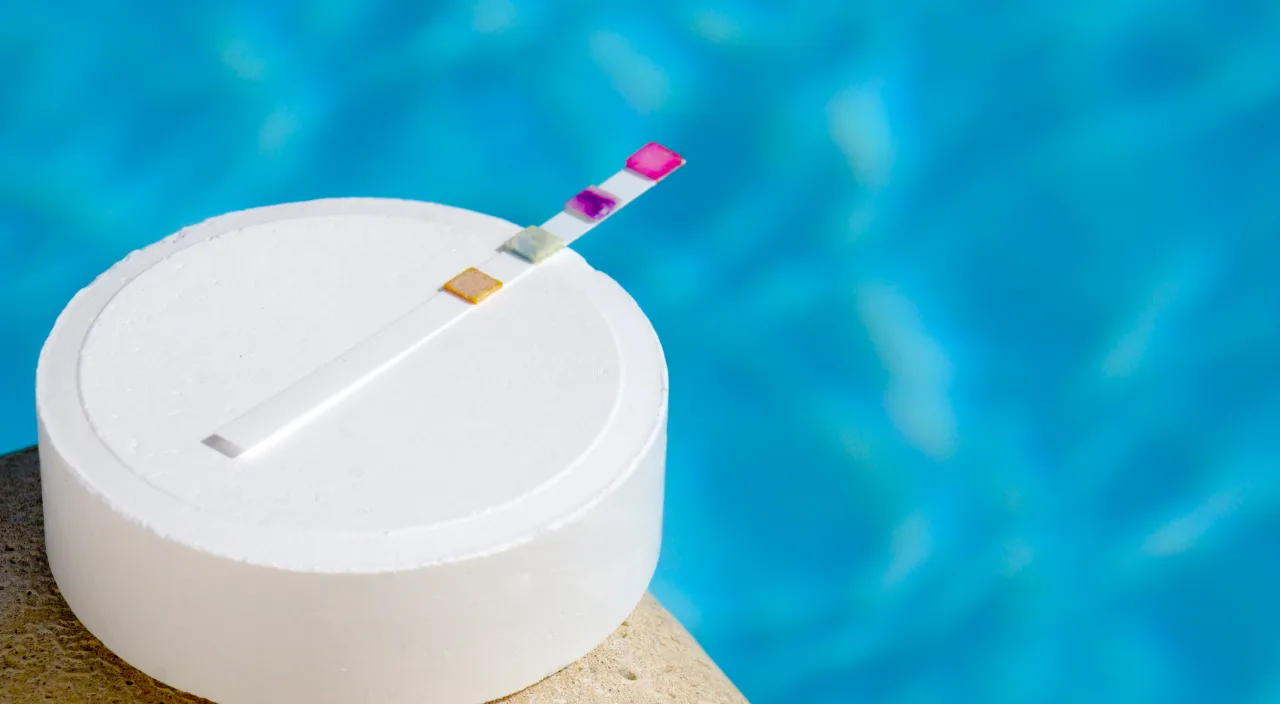1. Introduction
Chlorine in pools plays an essential role in maintaining pool water quality, ensuring the safety and well-being of all users. Its main function is to eliminate microorganisms and prevent the proliferation of bacteria and algae, which can transform the pool into an unhealthy environment. Although the use of chlorine is widely spread, there are many myths related to its effects, generating doubts about its real efficiency and possible risks.
In this post, we will explore myths and truths about the use of chlorine in pools, demystifying incorrect information and bringing concrete data about how it impacts water health and bathers. Knowing how to separate fact from myth is essential for those who want to maintain a clean and safe pool.
Chlorine, although it has some side effects, such as possible skin dryness and eye irritation in some cases, continues to be the most effective disinfectant available on the market. Additionally, its correct use prevents major complications that can arise from inadequate water treatment. Balance in the use of this product is the key to maintaining the pool in ideal conditions.
In the next topics, we will clarify some common doubts, address the importance of maintaining chlorine levels within recommended parameters and discuss alternatives for those seeking gentler but equally effective water treatment options.

2. What is chlorine?
Chlorine is one of the most used chemicals in pool water maintenance due to its powerful disinfectant action. It works by eliminating bacteria, viruses and other harmful microorganisms that can develop in water, ensuring bathers’ safety. Chlorine not only helps keep water clean and free of pathogens, but also prevents algae growth, which can alter water color and quality.
There are different forms of chlorine available for pool treatment, each with its own characteristics. Liquid chlorine is widely used in automated systems and in large volumes of water, due to its ease of dosing and efficiency. Granulated chlorine is popular in residences, as it is practical and can be easily dissolved in water, allowing more precise control of disinfection levels.
Another very common option is chlorine tablets, which release the product gradually, being an excellent choice for those seeking a more durable treatment that requires fewer interventions. This form of chlorine is placed in floaters or specific compartments in the pool, ensuring disinfection over time without the need for frequent replacement.
The choice of ideal chlorine type depends on pool size, the filtration system used and personal maintenance preferences. The important thing is to always ensure that chlorine levels are within recommended parameters, so that water remains healthy and crystal clear.

3. Myths about chlorine in pool water
The use of chlorine in pools is surrounded by several incorrect assumptions, which often generate unnecessary concerns. Let’s unveil some of the main myths that circulate about chlorine effects and its action in water.
Myth 1: Chlorine is solely responsible for the pool’s strong odor.
One of the biggest misconceptions is thinking that the pool’s strong smell is related to excess chlorine. In reality, the characteristic odor arises from chlorine’s reaction with organic matter present in water, such as sweat, urine or body oils. When chlorine reacts with these substances, it forms compounds called chloramines, which are the real culprits behind the unpleasant smell. Well-treated pools, with chlorine at adequate levels, generally don’t have this strong smell.
Myth 2: Chlorine harms skin and eyes.
Another common myth is that chlorine causes severe irritations to skin and eyes. Actually, when chlorine levels are maintained within recommended standards, it is not aggressive to the human body. Irritations normally occur due to an imbalance in water pH, which, when outside ideal levels, can cause discomfort. Therefore, more important than chlorine itself, is ensuring that both pH and chlorine levels are well adjusted.
Myth 3: The more chlorine, the better the water disinfection.
Some people think that adding more chlorine to the pool means more effective disinfection, but this is a mistake. Excess chlorine can actually be harmful both to water quality and to bathers’ health. The ideal level of free chlorine in water should be maintained between 1 and 3 parts per million (ppm). Amounts above this can not only cause irritations, but also increase chloramine formation, making water less efficient in eliminating contaminants.
These myths, when properly understood, help demystify chlorine’s role and reinforce the need for balanced and constant pool maintenance.

4. Truths about chlorine effects
When used correctly, chlorine is one of the most effective agents for keeping pool water clean and safe. However, there are some facts about its effects that need to be understood to ensure proper maintenance and avoid problems.
Truth 1: Chlorine is essential for eliminating bacteria and viruses.
Chlorine’s main role in pool water is disinfection. It acts efficiently by eliminating bacteria, viruses and other harmful microorganisms that can harm bathers’ health. Without proper chlorine use, pool water would become an ideal environment for pathogen growth, increasing the risk of infections and waterborne diseases. Therefore, regular chlorine application is crucial to ensure the pool is safe for use.
Truth 2: Chlorine can cause irritation if water is not properly balanced.
Despite chlorine being safe when used at adequate levels, it can cause irritation to skin, eyes and even respiratory tract if pool water is not correctly balanced. This generally occurs when water pH is outside the ideal range or when there is excess chlorine. A pH between 7.2 and 7.8 is recommended to avoid this type of irritation, ensuring a comfortable experience for all bathers.
Truth 3: The combination of chlorine with organic compounds generates chloramines, which are responsible for the odor.
The strong smell that many associate with chlorine actually comes from chloramines, compounds formed when chlorine reacts with organic substances present in water, such as sweat, urine and body oils. These chloramines, besides being responsible for the characteristic odor, can also diminish chlorine’s effectiveness in water disinfection. To avoid chloramine accumulation, it’s important to perform regular pool maintenance, including physical cleaning and chlorine replacement at adequate levels.
Understanding these truths about chlorine helps demystify its use and the importance of maintaining correct chemical balance in pool water, ensuring both safety and comfort for bathers.

5. How to maintain adequate chlorine levels in the pool
Maintaining adequate chlorine levels in the pool is fundamental to ensure water is always clean, safe and free from harmful microorganisms. For this, it’s essential to follow a routine of maintenance and water quality monitoring. The first step is to regularly measure the amount of chlorine present, using test kits or specific strips. The ideal free chlorine reading should be between 1 and 3 parts per million (ppm), ensuring effectiveness in disinfection without causing irritations.
Besides measuring chlorine, it’s important to consider water pH and alkalinity. The ideal pH for pools should be between 7.2 and 7.8, as values outside this range can compromise chlorine action. A very low pH (acidic) causes chlorine to evaporate quickly, reducing its effectiveness. A high pH (basic) can provoke eye and skin irritations, besides reducing chlorine’s disinfection capacity.
Another essential factor is total alkalinity, which should be maintained between 80 and 120 ppm. This parameter helps stabilize pH, avoiding fluctuations that can harm both bather comfort and chlorine efficiency. If alkalinity is outside recommended levels, chlorine can become less efficient, requiring a larger amount of product to obtain the same effect.
To ensure chlorine works correctly and water is always in ideal conditions, it’s recommended to adjust both pH and alkalinity before adding chlorine. This way, you avoid product waste and ensure the pool is always ready for use, with crystal clear and properly disinfected water.

6. Alternatives to chlorine
Although chlorine is widely used as the main method of pool disinfection, there are alternatives that offer an equally effective solution to keep water clean and safe. Methods such as bromide, ozone and UV light are becoming increasingly popular, especially for those who want to reduce exposure to chemicals or seek more natural water treatment options.
Bromide is a common alternative to chlorine, especially in spas and heated pools. It has a disinfectant action similar to chlorine, but with less odor and less irritating to skin and eyes. However, bromide tends to be more expensive and may need supplements of other chemicals to maintain its effectiveness over time.
Another option is ozone, a powerful oxidant that eliminates bacteria, viruses and other water contaminants without using chemicals. The ozone system works by injecting ozone gas into pool water, where it efficiently destroys microorganisms. Although highly effective, it doesn’t maintain a protective residual in water, which means it’s often necessary to combine ozone with small doses of chlorine or another disinfectant agent.
Ultraviolet (UV) light is a growing technology in pool treatment. It uses UV rays to disinfect water by breaking down the cellular structure of microorganisms. One of the main benefits of this method is that it doesn’t add any chemicals to water. However, like ozone, UV light doesn’t leave a residual in water, requiring combination with another disinfectant agent to ensure continuous pool protection.
These chlorine alternatives offer less aggressive methods for water treatment, but it’s important to consider that some may have higher initial costs and require constant maintenance to ensure effectiveness. The choice between these options depends on your budget and your pool’s specific needs.

7. Precautions when using chlorine in pools
Using chlorine in pool water is essential to keep water free from microorganisms, but it’s important to adopt certain precautions to ensure its application is safe and effective. When handling chlorine, it’s fundamental to follow safety recommendations and good practices, avoiding risks both to health and to pool component integrity.
Firstly, safe chlorine application involves following correct dosage instructions. Excess chlorine can cause skin and eye irritations, while insufficient amounts can compromise disinfection effectiveness. To maintain adequate balance, it’s ideal to use chlorine and pH test kits regularly, adjusting levels as necessary. Generally, free chlorine level should stay between 1 and 3 ppm (parts per million) to ensure effective disinfection without harming users.
Additionally, it’s crucial to store chlorine in safe places protected from sunlight. Chlorine, whether in liquid, granulated or tablet form, is sensitive to heat and light, which can compromise its stability and effectiveness. Keep it in dry and ventilated places, away from children and animals’ reach, avoiding accident risks. Handling should be done wearing gloves and, if possible, protective glasses to avoid direct contact with skin and eyes.
Another important tip is never to mix chlorine with other chemicals. This practice can generate dangerous chemical reactions, releasing toxic gases. When adding chlorine to the pool, prefer to do it at night or during times when the sun isn’t so strong, as UV rays can degrade chlorine quickly, reducing its effectiveness.
Finally, to avoid adverse reactions, keep water properly balanced. Chlorine works more efficiently when pH is between 7.2 and 7.6. If pH is outside this range, it can increase eye and skin irritation in bathers, besides harming chlorine efficiency. Maintaining these precautions is fundamental to ensure a clean, safe and pleasant pool for all users.

Table: Recommended Chlorine and pH Levels for Pools
| Parameter | Recommended Level |
|---|---|
| Chlorine | 1 – 3 ppm |
| pH | 7.2 – 7.8 |
| Alkalinity | 80 – 120 ppm |
| Calcium Hardness | 200 – 400 ppm |
8. Conclusion
The effects of chlorine on pool water are widely discussed, and it’s essential to separate myths from truths to ensure adequate and safe maintenance. As we’ve seen, chlorine plays a fundamental role in eliminating bacteria and other microorganisms, being indispensable for pool water health. However, many myths surround its use, such as the belief that it’s solely responsible for strong odor or that it harms skin and eyes. The truth is that chlorine, when used correctly, is safe and effective.
It’s important to remember that pool maintenance goes beyond simple chlorine application. Controlling water pH and alkalinity are crucial factors to ensure chlorine efficiency and avoid problems such as chloramine formation, which are actually responsible for unpleasant smell. The correct and balanced use of these elements contributes to a safer and more comfortable swimming experience.
Staying informed about proper use of cleaning and disinfection products is vital for those who want to enjoy the benefits of a healthy pool. Understanding truths about chlorine helps avoid common mistakes and maximizes water treatment effectiveness. Additionally, considering chlorine alternatives, such as using UV light or bromide, can be a good option, depending on each pool’s needs.
We encourage all pool owners to keep their pools well-treated, following chlorine use recommendations, performing frequent measurements and ensuring water chemical balance. This way, you ensure your pool remains a clean, safe and pleasant environment for everyone.
We want to know your opinion! Share in the comments your experiences with using chlorine in pool water. Have you ever believed in any of the myths we discussed? Or do you have any tips to keep your pool always clean and healthy? Also take the opportunity to follow our blog and stay updated with more tips and valuable information about pool maintenance, helping you keep water always crystal clear and safe for the whole family!
FAQ’s
1. What’s the problem with entering a pool with chlorine?
Entering a pool with chlorine at adequate levels generally doesn’t present problems, as chlorine is an effective disinfectant that helps keep water clean and safe. However, if chlorine levels are excessive, it can cause irritation to eyes, skin and respiratory tract. Therefore, it’s essential to monitor and maintain adequate chlorine levels to ensure a safe and pleasant experience.
2. What can pool chlorine cause?
Chlorine, when used at correct levels, is effective in eliminating bacteria, viruses and other contaminants in pool water. However, if in excess, it can cause skin irritations, red eyes and respiratory problems, especially in sensitive people. Additionally, the presence of chloramines, formed when chlorine reacts with organic materials, can result in unpleasant odors and discomfort.
3. What are the harmful effects of chlorine in water?
The harmful effects of chlorine in pool water can include skin and eye irritation, especially at high concentrations. Inadequate chlorine use can lead to chloramine formation, which is responsible for strong smells and respiratory discomfort. Additionally, frequent exposure to high chlorine levels can trigger allergic reactions in some people, making regular control of disinfectant levels in water essential.
4. What does chlorine do to the pool?
Chlorine plays a crucial role in maintaining pool water quality, functioning as a disinfectant that eliminates unwanted microorganisms, such as bacteria and algae. Additionally, chlorine helps oxygenate water, contributing to a healthy and safe environment for bathers. However, it’s vital to monitor chlorine levels, as both lack and excess can compromise water health and user well-being.

